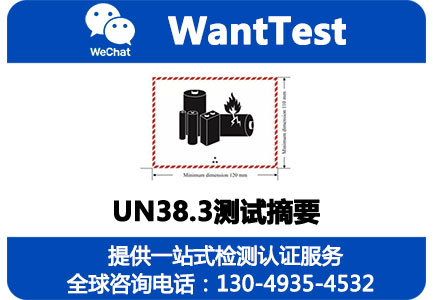What is UN38.3 test report
What is UN38.3?

Introduction:
• Many agencies require UN38.3 test report of the goods before transportation.
• UN38.3 has been derived from "The United Nations Recommendations on the Transport of Dangerous Goods Manual of Tests and Criteria".
• UN38.3 test report consists of following tests.
- Altitude simulation
- Thermal test
- Vibration test
- Shock test
- External short circuit test
- Overcharge test
- Forced discharge test
- Impact/Crush test
UN38.3 Test Requirements
The tests are very useful specially for primary cells and batteries as well as secondary cells and batteries. Failures of goods can be due to many causes which include leakage, venting, disassembly, rupture, fire, voltage drop, temperature rise etc.
Following table mentions verious UN38.3 test cases.
| Test case | Description | Test | Criteria |
|---|---|---|---|
| Altitude simulation |
Low Pressure Testing Simulates Unpressurized Aircraft (Cargo Area) 15,000 Meter Altitude (50,000 Feet) |
Store Batteries at 11.6kPa for > 6 hours |
• No Leakage, Venting, Disassembly, Rupture, or Fire • Voltage within 10% of pre-test voltage |
| Thermal Test | Changes in Temperature Extremes: -40oC, +72oC |
Store Batteries according to the following 6 hours @ -40C (12 hours for large cells/batteries) < 30minute transition 6 hours @ +72C (12 hours for large cells/batteries) <30 minute transition Repeat for total of 10 cycles May be performed in a single chamber or thermal shock chamber. |
• No Leakage, Venting, Disassembly, Rupture, or Fire. • Voltage within 10% of pre-test voltage |
| Vibration Test | NOT representative of expected vibration profiles, only frequency range. (7-200Hz). Resonance weakness check |
• Cells and Small Batteries (up to 12kg) • High G resonance sweep (8G peak) • Large Batteries (>12kg) • Low G resonance sweep (2G peak) |
• No Leakage, Venting, Disassembly, Rupture, or Fire • Voltage within 10% of pre-test voltage |
| Shock Test | May/may not be representative of actual events Tests mechanical integrity |
• Small = 150g/6ms = consumer battery specs • Large = 50g/11ms = automotive OEM Specs |
• No Leakage, Venting, Disassembly, Rupture, or Fire. • Voltage within 10% of pre-test voltage |
| External Short circuit | Simulates an external short to the terminals of the cell or battery. |
• Sample case monitored for temperature. • Stabilize sample at temperature of +55C • Apply short circuit (< 0.1ohm) across terminals. • Maintain at least hour after sample temperature returns to +55 +/-2C. • Remove Short circuit and monitor sample for additional 6 hours. |
• Case temperature does not exceed +170C • No disassembly, rupture, or fire within 6 hours of test. |
| Impact test |
• Simulates an impact to the case of the cell (Internal short circuit test) • For CYLINDRICAL cells >/=18mm diameter (includes 18650 cells) |
• 15.8mm diameter bar placed across the center of the sample. • 9.1kg mass dropped onto bar above sample from 61cm height. • One Impact per sample. • Sample monitored for 6 hours after test. |
• Case temperature does not exceed +170C • No disassembly or fire within 6 hours of test. |
| Crush test |
• Simulates crushing of a cell (alternative internal short circuit test) • For CYLINDRICAL cells < 18mm diameter, all other cell constructions |
Cell is crushed between 2 flat plates until • A: 13kN is reached • Cell Voltage drops 100mV • Cell thickness drops by 50% |
• Case temperature does not exceed +170C • No disassembly or fire within 6 hours of test. |
| Overcharge test |
• Simulates an overcharge condition on a rechargeable Battery. • Although not typically charged during transport, considers a battery being transported after an overcharge event occurs. |
2x the manufacturers recommended charge current for 24 hours. Charge Voltage applied: - If MaxV is 18V or less: 2x charge voltage, up to 22V - If MaxV > 18V: 1.2x maximum charge voltage |
Monitor for 7 days for Fire or Disassembly |
| Forced Discharge test |
Simulates a forced discharge condition: - Misconnected charger - "Dead" cell in series with "good" cells |
• Use +12V DC Power Supply and load resistor. • Duration is calculated from the rated Amp hours of the cell • Duration(h) = rated Ah / InitialCurrent (A) |
No disassembly or fire within 7 days of test. |

